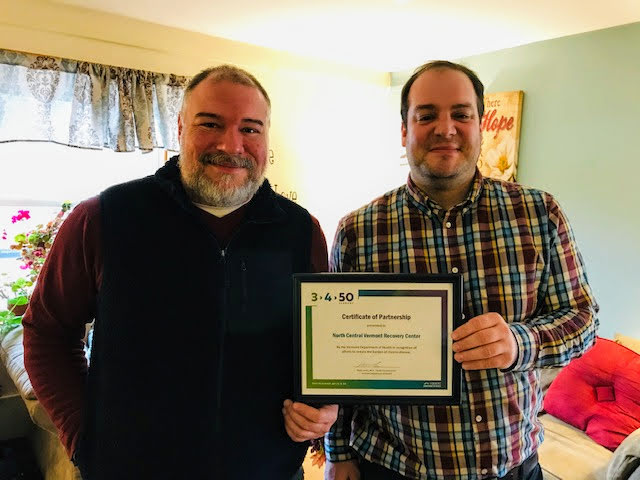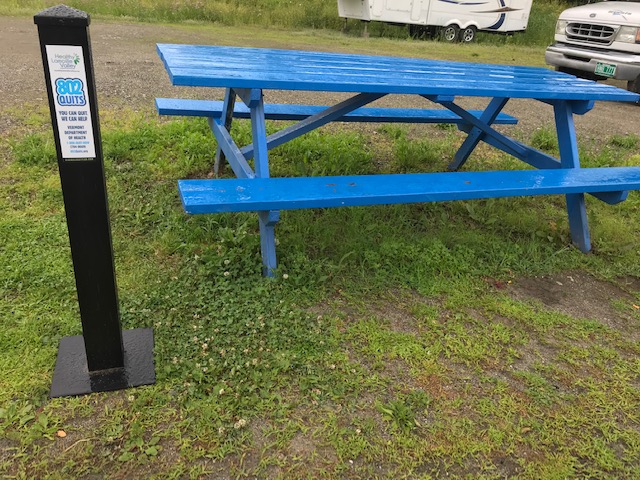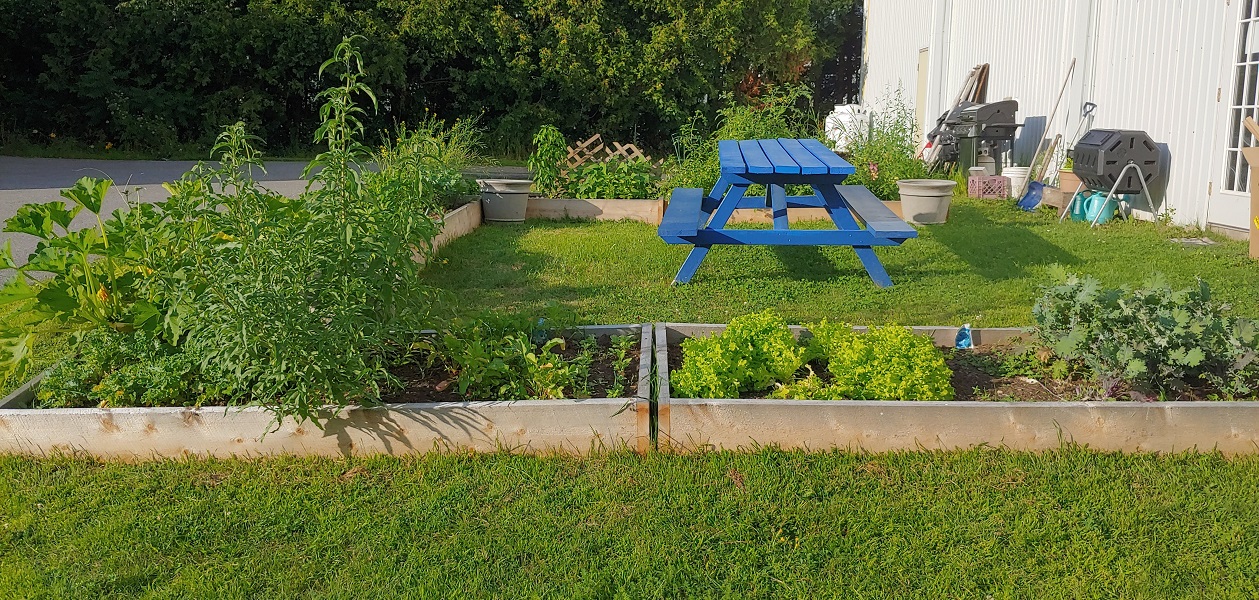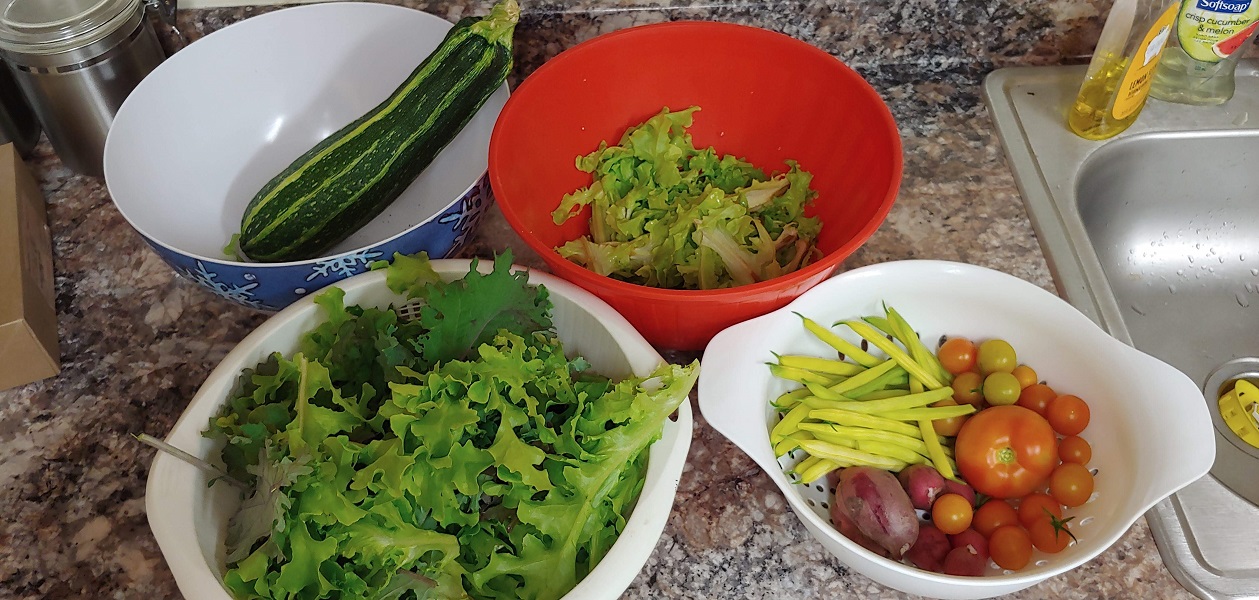
Executive Director Daniel Franklin (right) holds NCVRC’s 3-4-50 Certificate of Partnership with Operations Manager Mike Privee (left)
By Daniel Franklin, Executive Director, North Central Vermont Recovery Center
In 1978, famed anthropologist Margaret Mead said “Never doubt that a small group of thoughtful, committed citizens can change the world: indeed, it’s the only thing that ever has.” I think of this quote often as I work with community partners, as we create new task forces or start new services, or as we collaborate to apply for grants to help create positive changes in our communities. This quote speaks to the power that each of us has through our choices and our actions and even through the language we use as individual people, as organizations, and as members of a community. Each of us is a part that makes up a whole at many levels, from a household all the way up to the global community. We are a part of something greater than ourselves. Everyday decisions about what we eat, about whether we exercise, about whether we smoke, and about any other number of seemingly mundane and commonplace activities inform our individual health over the course of a lifetime. But beyond that, the health and well being of each one of us – mental, physical, financial, and otherwise – in turn affects the people and environment around us. We all have a butterfly effect for better or for worse. We can change the world, and create a better world, through the collective impact of our individual choices and actions if we so choose. We can each make a difference.
3-4-50 is just one small way North Central Vermont Recovery Center has endeavored to improve our community. In the fall of 2018, NCVRC was approached by representatives from the Vermont Department of Health and Healthy Lamoille Valley, Val Valcour and Alison Link, about signing onto the 3-4-50 chronic disease initiative. At its core, 3-4-50 highlights the fact that 3 behaviors (lack of physical activity, poor diet, and smoking) cause 4 diseases (cancer, heart disease, type 2 diabetes, and lung disease) that account for more than 50% of all deaths in Vermont. The initiative endeavors to address these behaviors and poor health outcomes by enlisting workplaces, schools, faith-based communities, cities and towns to take steps to promote healthy options and healthy decisions by employees and the people we serve. Whatever the type of entity, this initiative provides a concrete, measurable, and rewarding way to make even small changes to an environment in order to make healthy choices easier choices.

What struck me immediately is that 3-4-50 does not ask us to make grandiose, impossible or even difficult changes. It does not need to be costly to make a difference. And in some cases, 3-4-50 rewards us, if only symbolically, for what we’ve already done. Or, it raises awareness of what are already legal requirements for workplaces, such as smoke-free policies and breastfeeding spaces. As Val and I went through the checklist to achieve the bronze level, I could not only see that we were already there but also how we could get to the next levels by building on a strong foundation. To get to gold was not a competition with anyone else, but rather became a commitment to think about what we would do in the coming years to do our part to create a better environment for our employees and the people we serve. To achieve bronze, we continued to offer 802Quits smoking cessation courses and to promote 802Quits materials along with other information promoting community resources related to healthy eating and physical activity. We ensured that cigarette receptacles were across the parking lot from our building a safe and legal distance away, got a new “Buttler” receptacle through Healthy Lamoille Valley, and added signage about being a smoke-free facility. Finally, the bronze level rewards encouraging employees to take active breaks and to hold active meetings to get people up and moving.
To achieve each level, you qualify by fulfilling some but not necessarily all of the ideas provided. And the regional designees work with you to see what else your organization can do or has done to promote the program objectives related to the three core behaviors. There’s even a section where you can customize your own wellness goals and measures you will take. There is a lot of flexibility built in for organizations of all kinds and sizes.
We achieved silver by having a kitchen/break room with refrigerators and microwaves and other amenities and through a number of other initiatives around nutrition, smoking, and spaces for healthy activities like basketball. We also worked with Overeaters Anonymous to bring two new support groups to NCVRC, recruited several recovery coaches specializing in eating disorders, and got rid of some of the unhealthy foods that typically were laying around the center at the time through donations. We ensured there were some healthy snacks for staff and guests available, which was one of the few ongoing costs. We also expanded the center’s health and wellness services in partnership with local practitioners including yoga, AcuDetox, and reiki for recovery.

Perhaps the biggest and most impactful move we made that got us to the gold level and that helped in a long-lasting and significant way came in 2019. We of course continued and enhanced all of the above initiatives. But we also built a garden in the Spring of 2019 with the help of a $250 Healthy Lamoille Valley mini-grant, a $1500 RiseVT grant, and a donation from a local physician. We built raised beds, bought fertilizer, and planted numerous types of fruits and vegetables while also purchasing a new composting system and ensuring that there were healthy foods around the center for staff and guests alike to eat. These gardens helped us facilitate Expanded Food and Nutrition Education Program (EFNEP) courses, hold community meals, have healthier holiday meals, and provide volunteer opportunities for members of the community who wanted to contribute and also benefited from the meals. Staff meetings and support groups were often held at picnic tables surrounded by the garden, and everyone had access to more nutritious foods. Since the summer of 2019, hundreds of people have benefited from thousands of meals from our gardens, including during the spring of 2020 when the Covid-19 pandemic brought widespread food insecurity. We became a significant distributor of food starting in March 2020 and over the next several months.
In 2021, we will achieve yet another major gold-level milestone through the completion of a new fitness center and expansion of health and wellness services that will be available for both our employees and the people we serve. We will also add a second community garden at Jenna’s House in Johnson, which will serve as a satellite facility for NCVRC in partnership with Jenna’s Promise.
These are simply examples of our actions – big and small – that were complementary with and facilitated by 3-4-50 and our regional partners. However small, each change we made was more impactful than we could have imagined, and gave way to others that will keep our momentum going. I hope others will see that such actions are achievable and worthwhile for any organization, and if we each do our part we will not just help reduce chronic diseases that are a leading cause of death for Vermonters. We will make our communities better and improve lives.

Photo Credits: NCVRC
